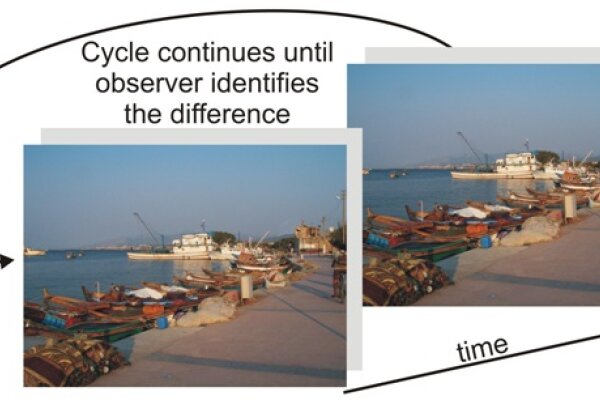2010-04-22

Do you see the difference between the two pictures? No? Then you are in good company. If the two pictures would simply alternate on a monitor, you would instantly see the difference. However, when a brief pause or a blank (like the grey partition in our example) is interposed between the two pictures, a person can sometimes gaze for minutes at the constantly switching two figures (and their interposed partitions) without detecting even very large changes in the scene. This phenomenon is called Change Blindness and it is to some extent still a mystery. Very likely, change blindness critically depends on attentional mechanisms. Visuo-spatial attention is lateralized towards the right hemisphere (left visual field). Wouldn’t we then expect change blindness to be more pronounced in the right visual field? In two successive experiments, psychologists from Izmir and Bochum tested this assumption and could prove it. Indeed, subjects could detect changes significantly faster in the left visual field, irrespective of their eye movements. Thus, even in cases when they started with a saccade to the right side of the picture, they were more likely to detect the difference on the left side of the picture.
Do you see the difference between the two pictures? No? Then you are in good company. If the two pictures would simply alternate on a monitor, you would instantly see the difference. However, when a brief pause or a blank (like the grey partition in our example) is interposed between the two pictures, a person can sometimes gaze for minutes at the constantly switching two figures (and their interposed partitions) without detecting even very large changes in the scene. This phenomenon is called Change Blindness and it is to some extent still a mystery. Very likely, change blindness critically depends on attentional mechanisms. Visuo-spatial attention is lateralized towards the right hemisphere (left visual field). Wouldn’t we then expect change blindness to be more pronounced in the right visual field? In two successive experiments, psychologists from Izmir and Bochum tested this assumption and could prove it. Indeed, subjects could detect changes significantly faster in the left visual field, irrespective of their eye movements. Thus, even in cases when they started with a saccade to the right side of the picture, they were more likely to detect the difference on the left side of the picture.